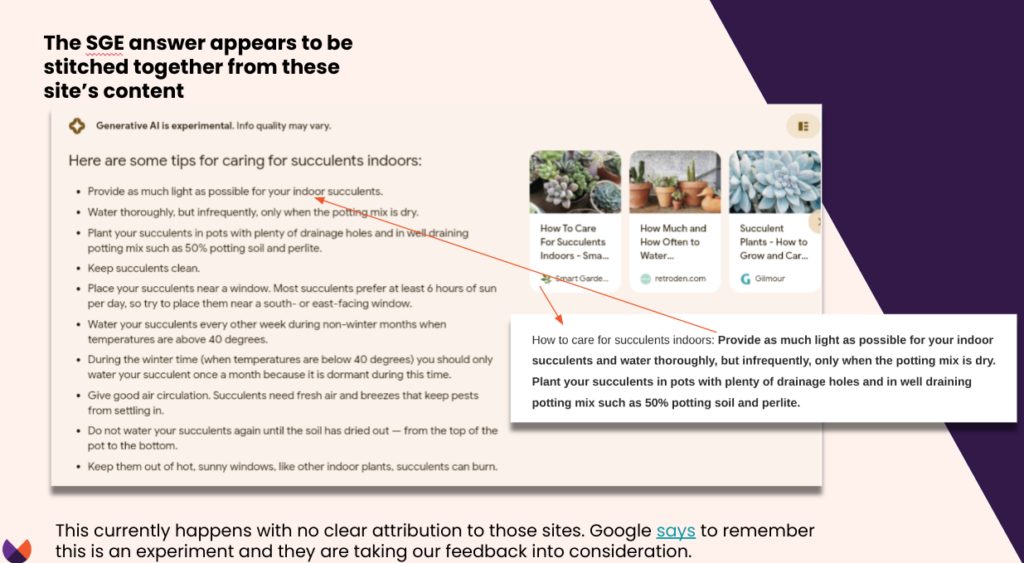Exploring the SGE | Material You provides the colors| SERP turbulence: Episode 289 - Jun 5, 2023
Last week’s episode (288) See all episodes Subscriber Content
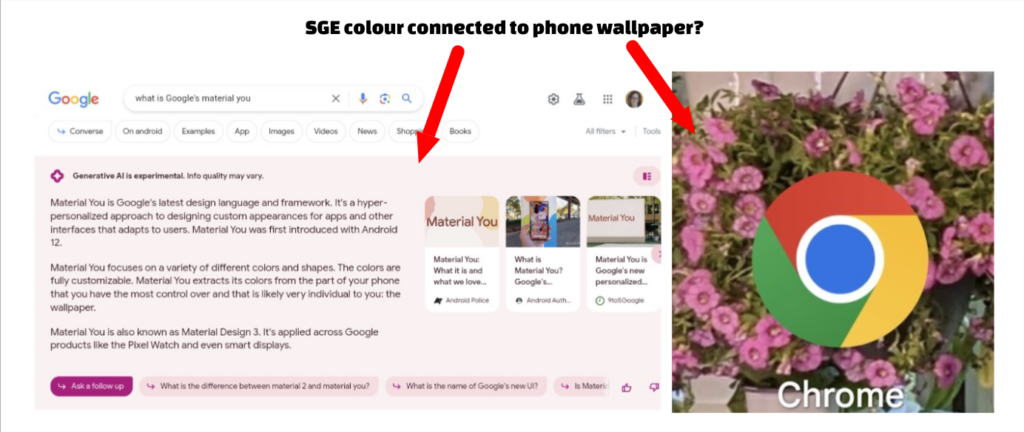
In this edition, I share what we learned this week about Google’s Search Generative Experience and its colour guidance through Material You, delve into AI’s impact on SEO, and celebrate a website’s comeback from a traffic slump. I’ll also talk about the latest Bard news and interesting AI research.
In this episode
Important this week:
- The latest on the SGE
- Material You: The technology behind the colours of the SGE
- Significant Turbulence in the Search Results
- Google Perspectives rolling out
- Bard News
- New Google Research Indicates Significant Leap Forward in Image and Text Search
- Search Console Insights now shows performance insights for sites not associated with GA
- New Nvidia AI supercomputer
- OpenAI trained a math model by rewarding the process instead of the final answer
- AI generated dialogue in video games
- Bard now wants your location
- A fascinating dive into what the QRG says about social media followers and reputation
- More info from the QRG with examples demonstrating experience
- Links to some of my ChatGPT discussions and prompts I used this week
- My summary of a great Twitter thread with SEO advice.

See all subscriber PDFs.
The latest on the SGE
Google’s Search Generative Experience is in beta and being tested by many who have been given access. I saw a few more people tweet this week about recently getting access. I would encourage you to get on the waitlist here. If you are not from the US, I have found a VPN works. It’s a bit of a pain to have to switch back and forth. ChatGPT will not let me in with a VPN.
I have best success making the SGE appear by using it on my phone, in desktop mode.
Observations on the SGE
It’s important to note that the SGE is in beta testing. The final product that eventually goes live may look different.
I have found that the SGE appears sometimes and then other times all I have access to is converse mode…especially when I want to take a screenshot of something!
The SGE answers are NOT the AI generated answers I thought they would be! At least for now.
I have been calling the text that the SGE generates, “Google’s AI generated answers”. My expectation for this text is that it would be an answer generated mostly from information in the knowledge graph and shopping graph. Knowing the connections between this information is something that sets the stage for the real magic, enabling nuanced and insightful responses beyond just fact-based answers.
However, the SGE seems to be not generating its own text, but rather, weaving together pieces of indexed information, taken from websites, into coherent and helpful responses. There’s no attribution to specific websites used to make this answer.
Here is a slide from a review I completed this week. This SGE generated answer is completely pieced together from websites without providing any links to those sources.
I think it’s possible that when live, or perhaps some time later, the SGE will be an AI generated answer that relies less on indexed content and instead, takes full advantage of the AI’s ability to understand and leverage what Google described in its Bard announcement as combining the breadth of the world’s knowledge with the power, intelligence and creativity of Google’s large language models, drawing on information from the web to provide fresh, high-quality responses.
With that said, I was able to get the SGE to produce results that do not reference websites. These coding questions appear to be AI generated rather than stitched together. I searched for several chunks of text in these answers and they do not seem to be taken from a website. I expect these answers are generated using Bard.
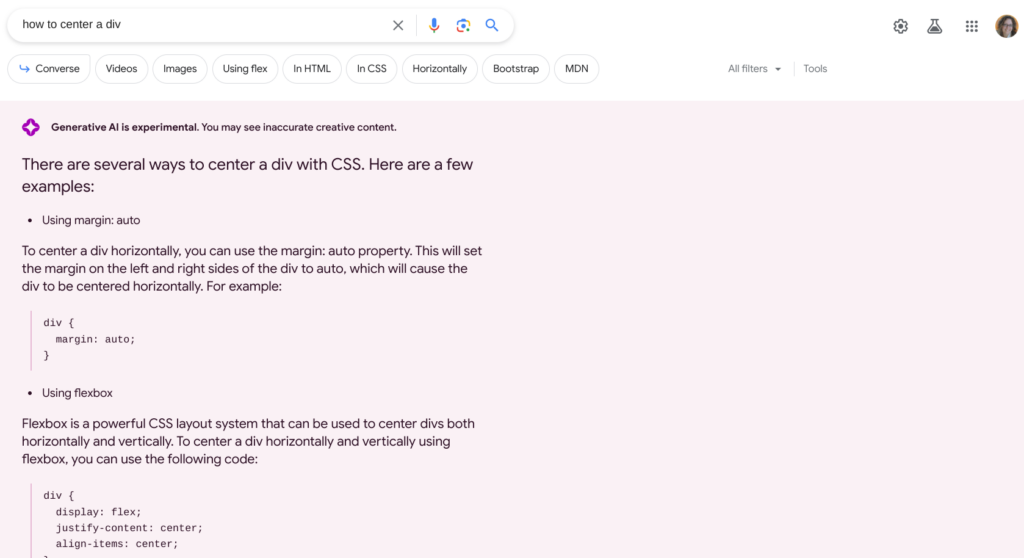
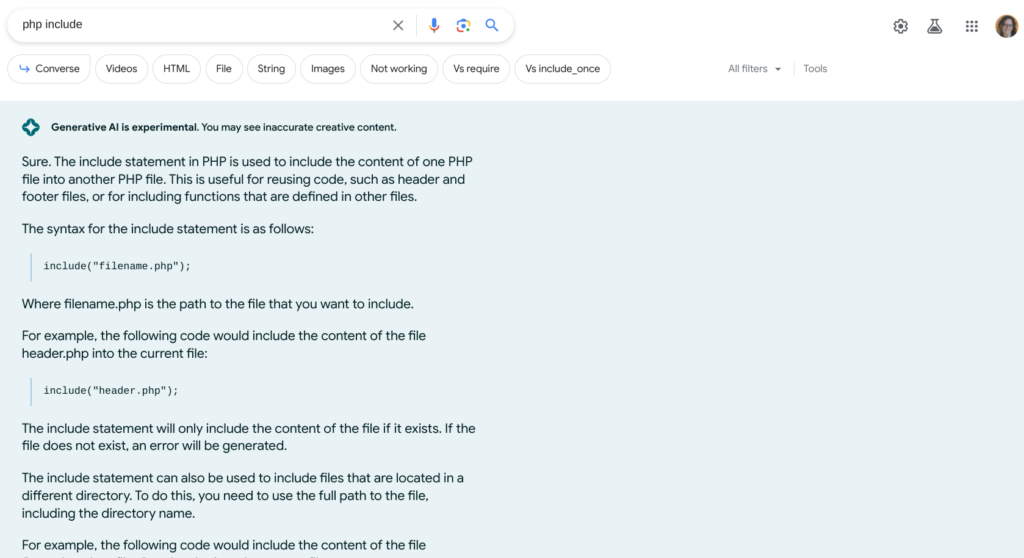
Does the SGE appear by default?
Kevin Indig noted that for him the SGE doesn’t show AI results by default although I have had it immediately generate an SGE answer for me without me asking.
Does the SGE show personalized results?
No more than what we currently see.
Example eCommerce search:
[I'm searching for a Bluetooth speaker that has extended battery life.]
(バッテリー寿命が長いBluetoothスピーカーを探しています)#SGE pic.twitter.com/saxEVDPAan— Kenichi Suzuki💫鈴木謙一 (@suzukik) May 31, 2023
Good thread with thoughts from Gianluca Fiorelli:
However, the most interesting thing is this: if we expand the window so as to see the citations inlined, we can see what part of the text is referenced to a source… pic.twitter.com/TGRpSEp1GY
— Gianluca Fiorelli (@gfiorelli1) May 31, 2023
A note from Alicia Gilbert-Marshall:
These three little boxes really limit how much of the title tag users can see pic.twitter.com/yp8pDhh7Gp
— Alicia Gilbert-Marshall ✨SEO (@thealiciamars) May 31, 2023
Cyrus Shepard listed 7 categories that don’t currently trigger AI results:
- navigational queries
- recipes (although I can get it to do simple things like, “how to cook broccoli”)
- NSFW (lol, his query was “naughty pictures”)
- some YMYL
- news and current events
- quick answers like weather, song lyrics
- sensitive queries
Some thoughts from Gael Breton:
Significant SERP turbulence at the end of May
The Semrush Sensor and Mozcast both spiked this week (before we had the news of Perspectives rolling out.) I’ve seen several reports of sites seeing jumps in rankings:
👀👀 so nice to see this pic.twitter.com/xMmDxGQ6Vb
— Sarah Tamsin // Web Dev & SEO ✨ (@Tamsininnit) June 1, 2023
There are several sites that I monitor that have significant changes around May 26-27. The Semrush sensor is up on June 1. Mozcast had a very high temperature of 125 on June 1 as well.
There has been no official word from Google on an update. I expect Google is doing more and more to prepare the SERPs for the coming changes we will see with their new AI powered search engine.
We are still awaiting the Perspectives update which will better reward first hand experience.
Material You: The technology behind the colours of the SGE
The SGE produces different coloured backgrounds for searches but it’s hard to figure out why each colour is shown.
This tweet from Jeannie Hill sent me on an adventure to discover more about this thing called Material You – a design language from Google.
Here’s what Google’s documentation on the SGE says about colour
“The use of color will evolve to better reflect specific journey types and the query intent itself.” What does that even mean? After reading this article on Android Police, I realized that this is probably related to something called Material You.
Material You
Material You is a design language. I had never heard that term before. Bard says a design language is “a set of rules and principles that guide the design of a product or service. It defines the look and feel of the product, including its colours, fonts, shapes, and overall style.”
This design language doesn’t just change colours on a page. It creates a unique palette for each person based on your personal preferences. Google’s announcement of Material You in 2021 says the colour palette is based on your wallpaper.
Check this out. Here’s a search I did on my phone. (It is the desktop version because for some reason I’m more likely to get the SGE that way.) It sure looks like the background colour is related to my phone background.
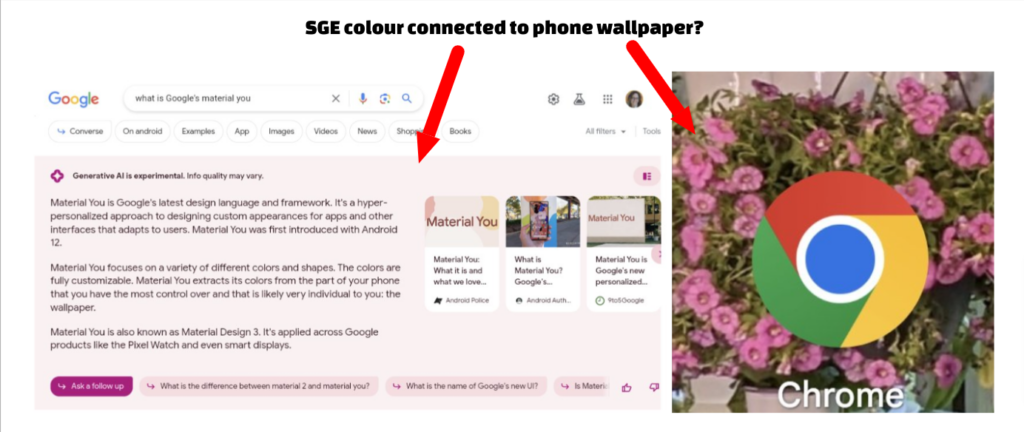
I changed my desktop background and it’s subtle, but it really does look like the SGE changed to adapt as well. It’s hard to say for certain though.


As I was testing this, David texted me from the garden asking me to Google a question about tomatoes.
I use a Google Pixel Phone. I’ve been noticing how the colours used when I text people are different. Most of my texts have a light green background…my texts to my husband have a dark greenish brown colour. I don’t know why.
Look what happened to my SGE when I jumped from David’s text to Google his question. The background is no longer pink, it’s green.
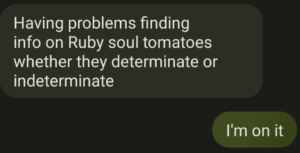

Then, later in the day I was working on a site review in Google Slides. I noticed that the background colour I was seeing in the SGE changed again to a tone that is almost (but not quite exactly) the same as the slides I created.
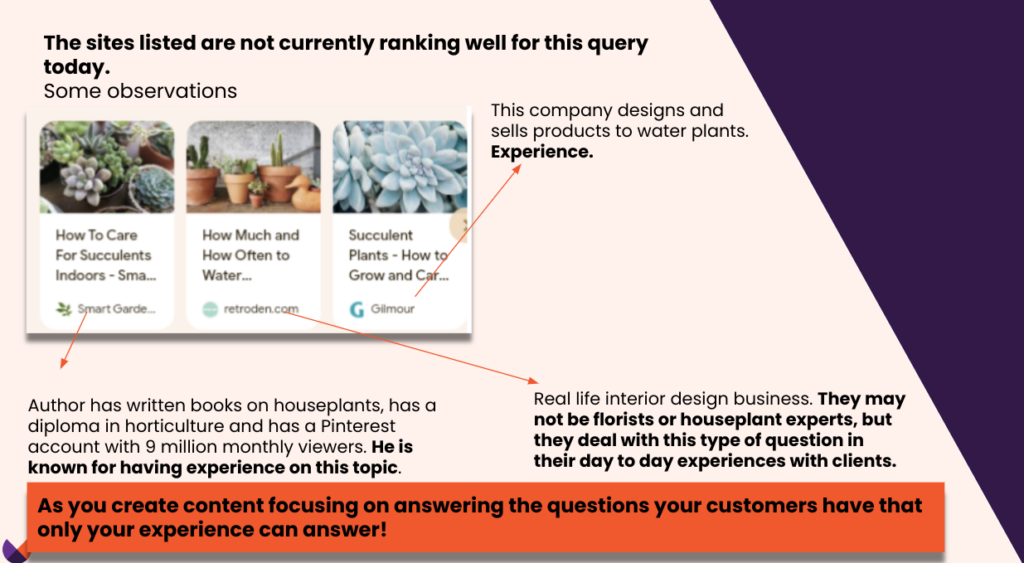
Then it hit me…this may be an example of what Google means by Journeys…Each journey has a different colour scheme. The colour scheme is designed to help us keep track of the many different ways we use Google’s products.
Journeys
Google Journeys were announced in February of 2022. In Chrome, click this icon on the top right of your screen and you can see your recent Journeys in Search.

I expect we’ll get used to using this sidebar as we navigate the web. It’s a perfect place to put Bard. Each of those Journeys likely will have a unique background colour that’s similar in tone to the background colour of your computer or phone wallpaper.
Google says the colour of the SGE also changes with query intent. I will be keeping an eye out to see if I can find patterns here. I do feel that I’m seeing more blue in commercial queries, but I will report back with examples if I can find some!
SEO Tips
More people are seeing Perspectives
Some started seeing search results with 3 featured snippets this week. Barry Schwartz tweeted this:


There was some confusion as to whether this was new. Rajan Patel, VP of Engineering at Google said:
Perspectives will have its own filter and is rolling out now on mobile in the US. These screenshots are previously launched improvements to featured snippets.
— Rajan Patel (@rajanpatel) June 2, 2023
Google’s blog post on Perspectives tells us they will use them in two ways:
- A Perspectives filter searchers can click on if they want to see “a page of results with advice form other people, like personal stories told through video, or tips from commenters in a forum thread.”
- A dedicated Perspectives section “that may appear on the results page” with a “more” link you can tap to see the full Perspectives filter content.
A few more SEO tips and news:
Google is showing “top rated” in some search results.
Love seeing "Top Rated" as a refinement here for shoppers.
Historically I've mainly seen "On Sale", "Nearby" and "Used" refinements here followed by product attributes, but those don't say much about ✨product quality✨
A big gap IMO. pic.twitter.com/7xyuT6s37N
— Brian Freiesleben v2 (@type_SEO) May 31, 2023
Reminder – the GA4 deadline is coming soon!
For GA4 procrastinators, @danaditomaso's free tutorial makes setup 10x easier
• Creating a property
• Google Tag Installation
• Measurement IDs
• Optimization settings
• Conversions + custom dimensions + metrics
• Linking Ads and Search ConsoleHow to Setup GA4 (Tutorial) pic.twitter.com/72b9gzfrXw
— Cyrus SEO (@CyrusShepard) May 31, 2023
Here’s how to turn off the scary countdown timer that pops up each time you use GA:
In the Admin section of UA, under the Property column, select GA4 setup assistant.
Once you get to this screen, scroll down and toggle off the "Automatically set up a basic Google Analytics 4 property." pic.twitter.com/oaTAf1eFS2
— Brie E Anderson | GA4, GTM, GDS (@brie_e_anderson) June 2, 2023
- Tony and his team used Google’s NLP API to improve content salience score, emphasizing the subject in the content.
- They used Sketch Engine to analyze top-ranking articles’ language patterns and improved their content based on findings.
- The team enhanced readability, added visuals, updated outdated information, and added more categories/subcategories.
- They worked with expert writers and editors, created a contributor’s page, and an “Ask an Expert” section.
- They improved the schema of each article and made extensive use of internal linking.
- They analyzed their success in Google Discover and created new articles on related topics.
- After a year of effort and updates, Tony’s site recovered and grew to nearly 8 million page views per month.
Several people have asked me lately to share more details on how I’m using ChatGPT in my day to day work. Now that we can share links directly to ChatGPT chats, in the subscriber PDF this week I’ve started sharing links to some of the conversations I had with ChatGPT in summarizing newsletter this week.
Search Console Insights now shows performance insights for sites not associated with GA
Search Console Insights got an upgrade for properties that are not associated with Google Analytics. This includes new content performance insights, such as your site's most popular and most trending pieces of content on Search. More about the association https://t.co/gyBfWMG4vH pic.twitter.com/ctyO5rvSbK
— Google Search Central (@googlesearchc) May 31, 2023
AI News
New AI supercomputer
Nvidia announced a new class of AI supercomputer. The DGX GH200 is the first supercomputer to pair Grace Hopper Superchips with the NVIDIA NVLink Switch System. This new interconnect enables all GPUs in a DGX GH200 system to work together as one, delivering the power of a massive AI supercomputer with the simplicity of programming a single GPU. They are calling it the world’s first high performance ethernet for AI.
Also from Nvidia this week is a new model that reconstructs 3D scenes turning 2D video clips into 3D structures.
AI generated dialogue in video games
Video games are going to change. Nvidia demoed this clip that was AI generated. None of this character’s lines were scripted. He was just given a back story and AI allows the video game player to converse with him.
Nvidia’s CEO also said , the programming barrier is incredibly low. We have closed the digital divide. Everyone is a programmer now – you just have to say something to the computer.
OpenAI trained a math model by rewarding the process instead of the final answer
This is fascinating.
[This is a big deal.]
New @OpenAI model sets a new standard in math problem-solving by rewarding each correct reasoning step, not just the final answer. This improves performance and aligns the AI's reasoning with human-endorsed thought processes.https://t.co/o5PBx74Ght
— DEJAN (@dejanseo) June 1, 2023
This OpenAI paper might as well have been titled “Moving Away From PaperClip Maxxing”
So good
– they took a base GPT-4, fine tuned it a bit on math so that it understood the language as well as the output format
– then no RL. Instead they trained and compared two reward… pic.twitter.com/3Tdi2kep98
— Ate-a-Pi (@8teAPi) June 1, 2023
More reading on AI and the SEO Industry:
The Purge: Why Generative A.I. is Coming for SEO Content Traffic, Jobs & Dependent Websites – Jon Cooper
SEO in the age of ChatGPT and LLMs – Good article by Ben Luong on the SGE and its potential impact on SEO. His conclusion: “SEO is dead for a lot of queries but for some, it might end up being better depending on the interface Google ends up adopting.”
Will Google’s AI plans destroy the media? – Nymag.com
Bard
Bard had an update June 1. It now can start providing more relevant responses based on location.
Bard wants location info now…looks like we'll be getting more local info in Bard soon.
It's still not quite right just yet. This query brought up some well known veterinary clinics near me but there are no links just yet.
This image links to a directory. pic.twitter.com/SmbCm3qoSe
— Marie Haynes (@Marie_Haynes) June 2, 2023
It’s interesting to see how the businesses Bard is recommending often comment on the number of Google reviews and the star ratings a business has.
You can use Bard to ask if pages are indexed. Colin McDermott says it works quite well. I tried using it to ask how many pages of my site were indexed and it made up a number that was definitely wrong. If you find good use cases for Bard in helping your clients, please do tweet about it and let me know!
Bard is faster than Bing because it uses a much smaller model.
Here’s an interview with Jack Krawczyk who works on Bard at Google.
LLM chat interfaces have taken the world by storm
but, they still have some trust issues, due to "hallucinations"
how does $GOOG solve this?
it gives Bard users the option to "Google it"@JackK breaks it down: pic.twitter.com/i7809JxCjE
— This Week in Startups (@twistartups) May 31, 2023
My summary:
- Google is putting Bard out there as an experiment despite its limitations with hallucinations because you can’t build technology that is helpful to people without getting it in their hands.
- When people start using something that’s vastly new technology they tend to want to use it like they have used similar technology before. For example, the first TV show was people reading a radio script. We are learning how to prompt. A 30-50 word prompt is going to be much more helpful than a short search query made up of a few keywords.
Mustafa Suleyman, co-founder of Google’s DeepMind suggests that websites are a thing of the past.
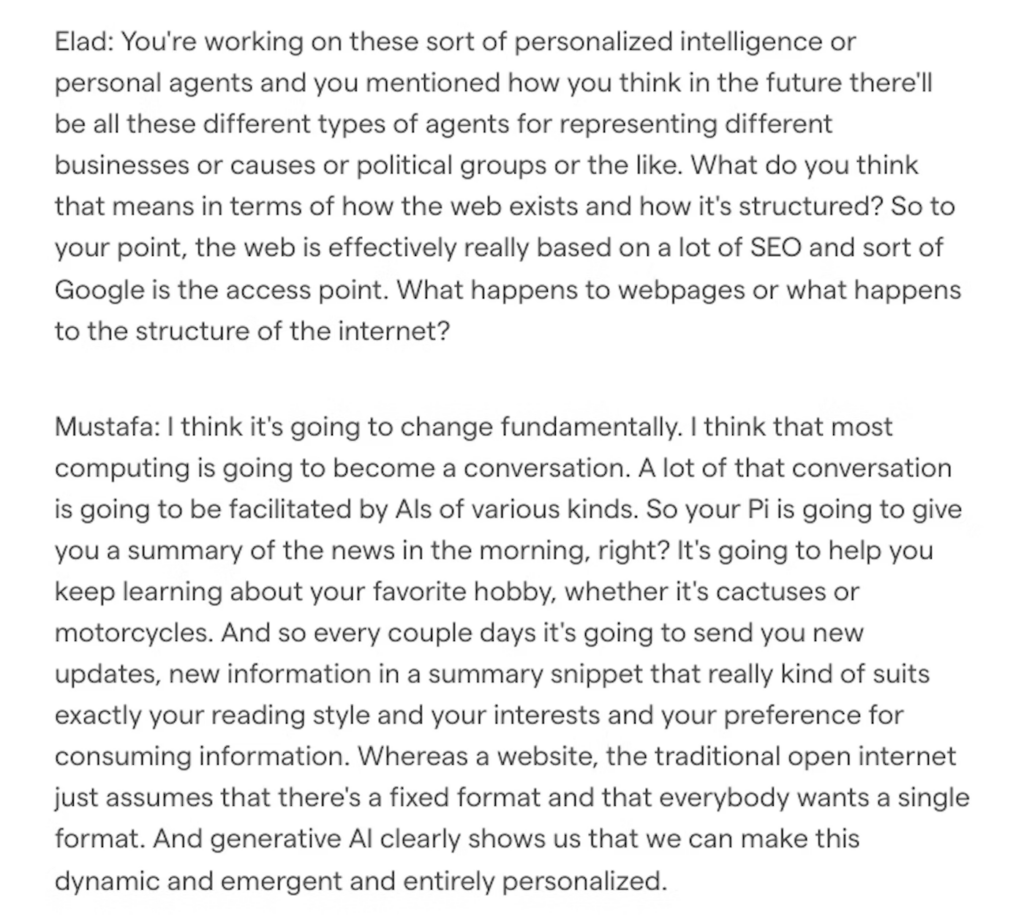
New Google Research Indicates Significant Leap Forward in Image and Text Search
Google’s new research paper “REVEAL: Retrieval-Augmented Visual-Language Pre-Training with Multi-Source Multimodal Knowledge Memory” introduces a new visual-language model that can process and interpret both text and image data simultaneously to answer complex queries. This approach allows the model to focus on reasoning about the query, rather than on memorization. The paper indicates that REVEAL could enhance the accuracy and relevancy of responses by retrieving information from multiple knowledge sources.
While the paper does not specifically state its immediate application on search engines, it suggests potential implications for improving the quality of search results in the future. I asked ChatGPT for more:

I expect this is quite relevant to Google Lens!
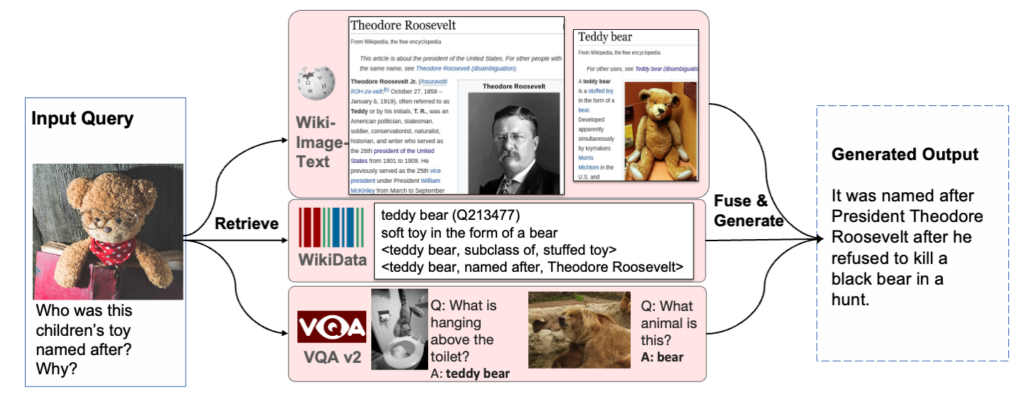
Other interesting news
Microsoft’s president says he believes AI regulation will happen in the coming year.
This Google study, AVFormer: Injecting vision into frozen speech models for zero-shot AV-ASR, presents a practical solution to enhance speech recognition by incorporating visual information. By introducing lightweight adapters and a visual projector, AVFormer achieves state-of-the-art performance on AV-ASR benchmarks while maintaining good performance on audio-only tasks. This research opens up new possibilities for improving speech recognition systems in real-world scenarios where visual cues can enhance accuracy and robustness.
Here’s an archived version of an article that OpenAI asked to be removed regarding their future plans. A few interesting things:
- OpenAI is extremely limited in GPU’s – the hardware needed to run ChatGPT
- They thought they’d be able to give a 32K context window (more stuff you can paste in) but they haven’t gotten there yet.
- There’s a service where you can pay $100K upfront to have dedicated capacity but it’s also limited by GPU’s.
- Their top priority is building a cheaper and faster GPT-4.
- There will be a stateful version of the API that remembers conversation history so you don’t need to pass the same tokens through each conversation.
- The multimodal capabilities demoed as part of GPT-4 can’t be released until there is more processing power.
- There’s no immediate plan to allow access to ChatGPT plugins via the API.
- OpenAI has no plans to release products other than ChatGPT.
- Sam Altman wants regulation but does not feel that current models are dangerous.
Bing chat will soon be available on all browsers. This means you’ll see more Bing screenshots from me as I have been unable to use it on my Chromebook!
GPT-4 is pretty good at Minecraft and this is a big deal.
GTP-4 Takes on Minecraft! ⛏️🤖
A new study introduces Voyager, an LLM-powered agent in Minecraft, which can learn and evolve without any human intervention.
– Voyager explores the world, builds new skills, and makes original discoveries independently.
– It interacts with GPT-4… pic.twitter.com/ixb5aebhUk— Alvaro Cintas (@dr_cintas) May 27, 2023
Local Search
Videos added to your GBP are appearing on mobile searches now.
30 second videos had only been visible in Google Maps. If a profile had a video it would be elevated to the second image position and auto start
This increased video visibility is now showing on mobile search in browsers and the mobile Google app as well
Time to add video! pic.twitter.com/pHWPHvIinb
— Mike Blumenthal (@mblumenthal) June 1, 2023
There is some discussion about businesses getting violations for Local Service Ads.
Google confirms donating to charities for reviews is against guidelines.
SEO Jobs
Looking for a new SEO job? SEOjobs.com is a job board curated by real SEOs for SEOs. Take a look at five of the hottest SEO job listing this week (below) and sign up for the weekly job listing email only available at SEOjobs.com.
SEO Strategist ~ Loganix ~ $60-70k ~ Remote (US)
Freelance Sr Content Writer ~ Semrush ~ Remote (WW)
Director of SEO ~ Seeking Alpha ~ $120k-180k ~ Remote (US)
SEO Manager ~ Vanta ~ $104k-$122k ~ Remote (US)
Sr. SEO Copywriter ~ Under Armour ~ $69k-$95k ~ Remote (US)
Subscriber Content
Each week I send some extra stuff to subscribers based on observations, insight and conversations I have with business owners as we navigate this new era of AI and search. This week’s extra content includes:
- A fascinating dive into what Google’s quality raters’ guidelines say about social media followers and reputation
- More info from the QRG with examples demonstrating experience
- Links to some of my ChatGPT discussions and prompts I used this week
- My summary of a great Twitter thread with SEO advice.

See all subscriber PDFs.
Or, sign up for the free version:
Stay up to date on the latest on SEO & AI News
I'll send you an email each week once I've published newsletter.


